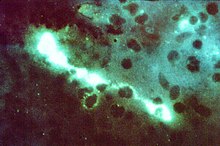Chlamydia psittaci
This article needs additional citations for verification. (October 2023) |
| Chlamydia psittaci | |
|---|---|

| |
| Direct fluorescent antibody stain of a mouse brain impression smear showing C. psittaci. | |
| Scientific classification | |
| Domain: | |
| Phylum: | |
| Class: | Chlamydiia |
| Order: | |
| Family: | |
| Genus: | |
| Species: | C. psittaci
|
| Binomial name | |
| Chlamydia psittaci[1] | |
| Synonyms | |
|
Chlamydophila psittaci | |
Chlamydia psittaci is a lethal
C. psittaci in birds is often
C. psittaci serovar A is endemic among psittacine birds and has caused sporadic zoonotic disease in humans, other mammals, and tortoises. Serovar B is endemic among pigeons, has been isolated from turkeys, and has also been identified as the cause of abortion in herds of dairy cattle. Serovars C and D are occupational hazards for slaughterhouse workers and for people in contact with birds. Serovar E isolates (known as Cal-10, MP or MN) have been obtained from a variety of avian hosts worldwide and, although they were associated with the 1920s–1930s outbreak in humans, a specific reservoir for serovar E has not been identified. The M56 and WC serovars were isolated during outbreaks in mammals. Many C. psittaci strains are susceptible to bacteriophages.
Life cycle and method of infection

Chlamydia psittaci is a small bacterium (0.5μm) that undergoes several transformations during its lifecycle. It exists as an elementary body (EB) between hosts. The EB is not biologically active, but is resistant to environmental stresses and can survive outside a host. The EB travels from an infected bird to the lungs of an uninfected bird or person in small droplets, and is responsible for infection. Once in the lungs, the EB is taken up by cells in a pouch called an endosome by phagocytosis. However, the EB is not destroyed by fusion with lysosomes, as is typical for phagocytosed material. Instead, it transforms into a reticulate body and begins to replicate within the endosome. The reticulate bodies must use some of the host's cellular machinery to complete their replication. The reticulate bodies then convert back to elementary bodies, and are released back into the lung, often after causing the death of the host cell. The EBs are thereafter able to infect new cells, either in the same organism or in a new host. Thus, the lifecycle of C. psittaci is divided between the elementary body which is able to infect new hosts, but can not replicate, and the reticulate body, which replicates, but is not able to cause new infection.
History
The disease caused by C. psittaci, psittacosis, was first characterized in 1879 when seven individuals in Switzerland were found to experience pneumonia after exposure to tropical pet birds. The causative pathogen was not known. The related bacterial species Chlamydia trachomatis was described in 1907, but was assumed to be a virus, as it could not be grown on artificial media. In the winter of 1929–1930, a psittacosis pandemic spread across the United States and Europe. Its mortality rate was 20% and as high as 80% for pregnant women. The disease's spread was eventually attributed to exposure to Amazon parrots imported from Argentina. Though C. psittaci was identified in 1930 as the agent responsible for psittacosis, it was not found to be a bacterium until examination by electron microscopy in the 1960s.[5]
Taxonomy
For several decades, the family Chlamydiaceae contained a sole genus, Chlamydia. C. psittaci was originally classified from the 1960s to 1999 as a species of this sole genus. In 1999, the order Chlamydiales was assigned two new families (Parachlamydiaceae and Simkaniaceae), and within the family Chlamydiaceae, the genus Chlamydia was divided into two genera, Chlamydia and the newly designated genus Chlamydophila, with C. psittaci becoming Chlamydophila psittaci.[1] However, this reclassification "was not wholly accepted or adopted"[6] among microbiologists, which "resulted in a reversion to the single, original genus Chlamydia, which now encompasses all 9 species including C. psittaci."[6] A new species was added to the reunited genus Chlamydia in 2013,[7] two more were added in 2014.[8]
What were once classified as the mammal-endemic strains C. psittaci abortion, 'C. psittaci
Diseases
C. psittaci infection is also associated with schizophrenia. Many other kinds of infections have been associated with schizophrenia.[9]
Genomics
Like other Chlamydia, C. psittaci is an intracellular pathogen and has thus undergone significant genome reduction. Most C. psittaci genomes encode between 1,000 and 1,400 proteins. A total of 911 core genes were found to be present in all 20 strains sequenced by Read et al., corresponding to 90% of the genes present in each genome.[10]
Confirmation of diagnosis
In addition to symptoms and CHX, complement fixation, microimmunofluorescence, and polymerase chain reaction tests can be used to confirm the diagnosis.
Treatment
Tetracycline or macrolides can be used to treat this condition. The drugs are given intravenously or orally, depending on drug choice. Treatment should continue for 10–14 days after the fever subsides. In children or pregnant women, though, tetracycline should not be used. Ibuprofen or acetominophen, and fluids are also administered. Cannabis or tobacco smoke should be avoided. While taking tetracycline, dairy products should be avoided.
See also
- Chlamydia infection
- Koala (Phascolarctos cinereus)
References
Further reading
- Brock Biology of Microorganisms (10th ed.). Upper Saddle River, NJ: Prentice Hall. 2003. ISBN 978-0-13-049147-3.
